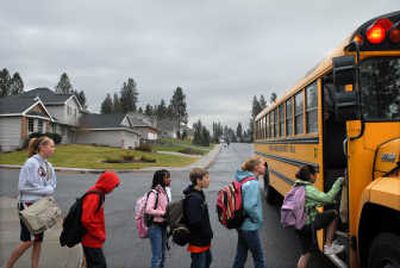Growing pains for Mead

Erica Hallock’s two children can walk to Midway Elementary School from their home in a neighborhood north of the Little Spokane River and east of Highway 395.
But the first- and fourth-graders can’t attend classes there anymore. A round of boundary changes within the Mead School District this fall has the siblings boarding a bus each morning for a ride to Farwell Elementary School, about five miles away.
And with growth showing no signs of slowing in the north Spokane County district, families like the Hallocks fear they may be asked to shuffle again in a few years.
“The district had done a very good job with a not-so-great situation,” Hallock said. “But I don’t see how with the current capacity we can handle any more new kids.”
Like the Central Valley School District to the east of the city, residential growth in suburban areas to the north of Spokane has forced Mead to grapple with a surge in its student population. It’s the opposite of what is happening in urban areas, where schools are losing students. Spokane Public Schools lost more than 600 students this year.
Mead officials say the shift in school boundaries this year has provided some breathing room in the Midway and Colbert areas, but it doesn’t appear to have helped much on the Five Mile Prairie, where unprecedented growth has taken place. The district spent $16.9 million in voter-approved bonds to build Prairie View Elementary on the Five Mile Prairie. Using Census and county data, a committee charged with looking at facilities determined the school would be two-thirds full, but when it opened this fall 545 students walked through the doors – 175 more than expected.
The district is looking at options to pay for portable classrooms at the site.
“There’s been steady growth, but it’s been manageable,” said John Dormaier, director of facilities and planning for Mead. “This was a bit of surprise at Prairie View.”
Parents fear that Mead’s situation could eventually mirror what’s happening in Central Valley.
After three failed bond attempts to build schools and ease overcrowding, CV is looking at alternatives such as busing, more portables and a longer school year so students can attend in shifts. Some elementary students eat lunch in classrooms because the schools are so full.
“I don’t want to be a Central Valley, where they are talking about year-round schools,” Hallock said. Like many people, they bought their house because it was within the Mead boundaries, a district with an excellent reputation, she said.
Some parents wonder whether school crowding is taken into account when subdivisions are approved, And sometimes they blame the district for the growth that causes crowding.
“Our biggest issue, that even our patrons don’t understand, is that school districts have no say in growth,” said Mead school board member Denny Denholm.
In fact, it’s county government – or the city of Spokane for areas within city limits – that has the final say on new subdivisions. The school district, as well as the community, can submit comments before plats are approved, said John Pederson, Spokane County assistant building and planning director.
But under county regulations, things like schools, parks, libraries and even fire protection are considered “indirect concurrency services” – meaning they don’t have to be in place before a plat is approved for development. Services that are required up front – called “direct concurrency services” in bureaucratese – are roads, water and sewer.
In the Wandermere area, residents and parents of Mead students have voiced concern about the impact of a proposed 208-unit complex along Hatch Road, called the Ridge at Midway. The complex could bring as many 200 new students to Mead, district officials told parents recently.
And growth continues on the Five Mile Prairie. Last year, the Eastern Washington Growth Management Hearings Board ruled that Spokane County commissioners improperly expanded “urban growth areas” on the prairie without required studies and consultation.
Before commissioners rescinded the expansions, developers obtained “vested” rights to build low- and medium-density housing on 220 acres on the prairie. The results could be hundreds more students.
“We have been complaining to the county, and the city council for the last several years,” said Craig Busch, president of the Five Mile Neighborhood Council. “The right hand isn’t talking to the left.”
Hallock says that some parents have pressed the school district about why they don’t ask the county and city to collect impact fees from developers, which ultimately falls on the homeowner.
Central Valley has unsuccessfully argued for the collection of impact fees by the three jurisdictions – the county, and the cities of Liberty Lake and Spokane Valley – within its boundaries. Liberty Lake has given the matter serious consideration, but has yet to collect fees.
At one time Mead collected impact fees, but those were refunded because of legal challenges, Dormaier said.
“Three years ago we chatted informally about the process of logistically putting impact fees into play again,” Dormaier said. “But it is a complicated process, and it would represent a relatively small value. With the construction costs as they are today it really doesn’t make a lot of impact.”